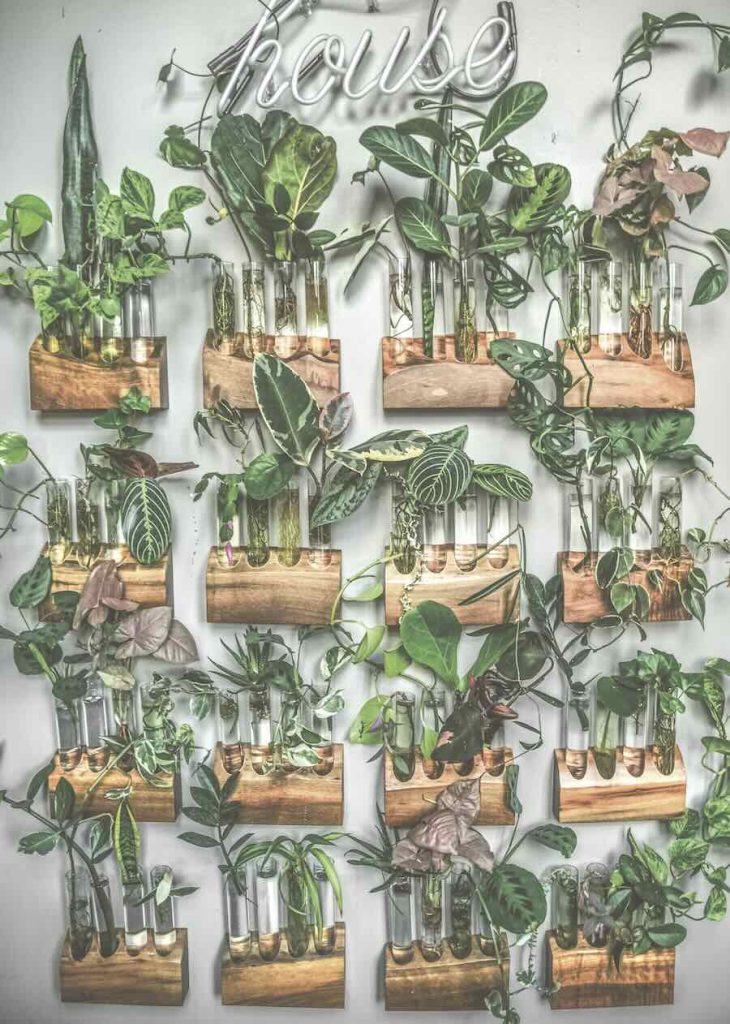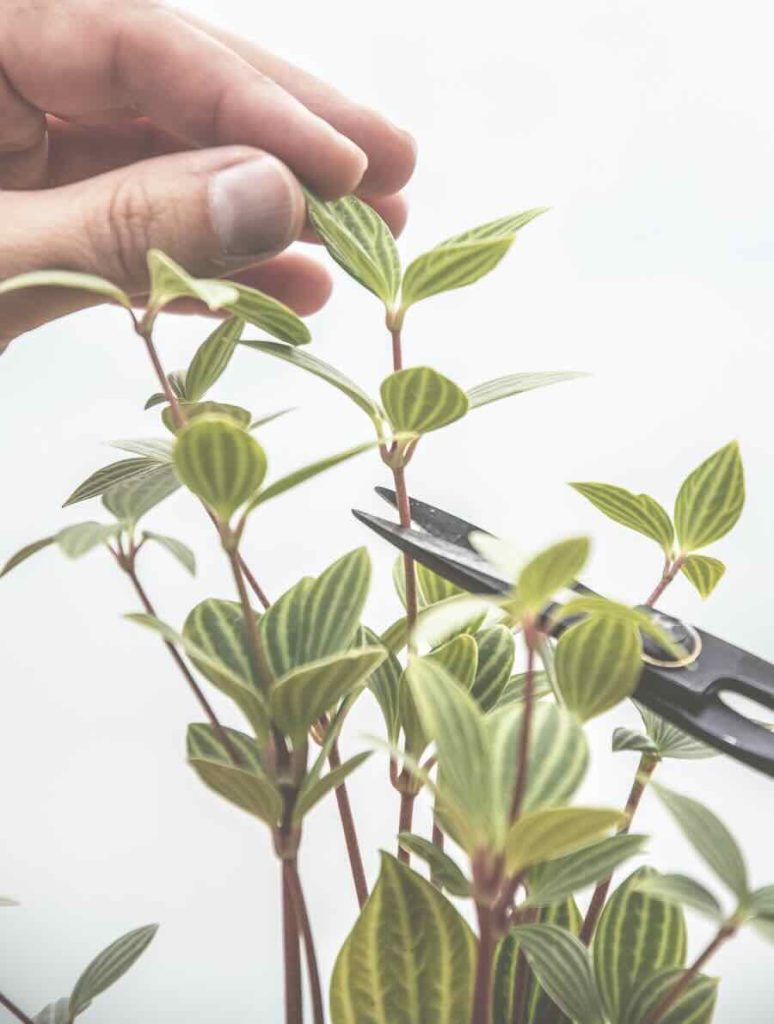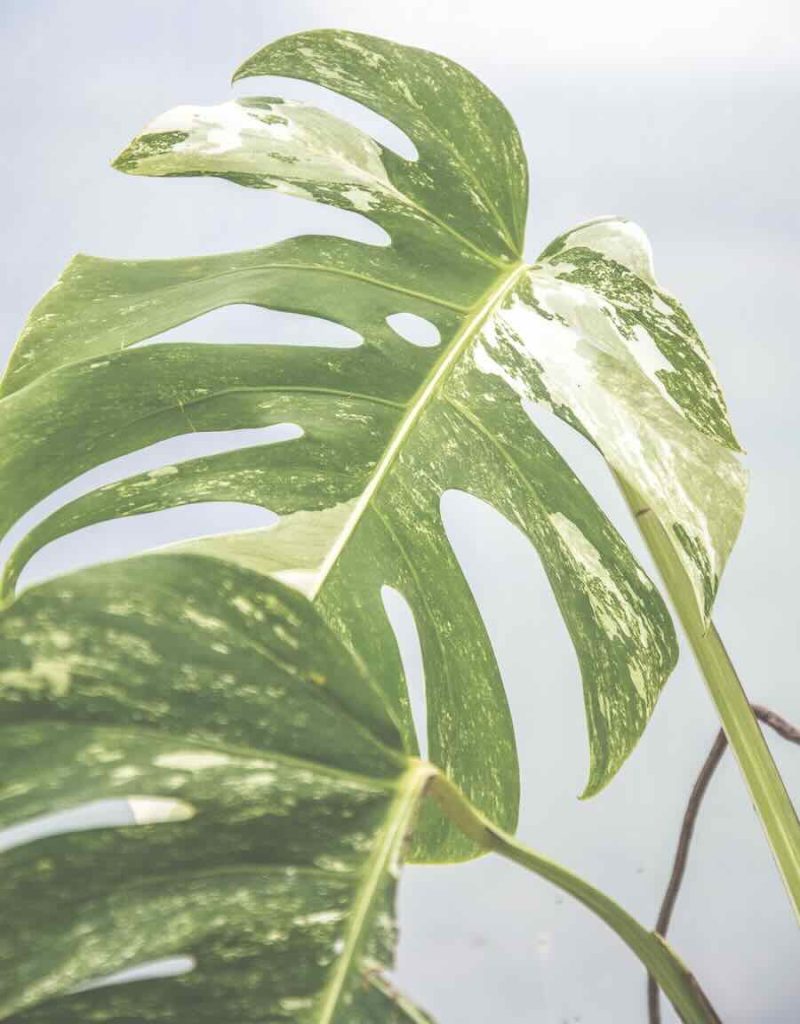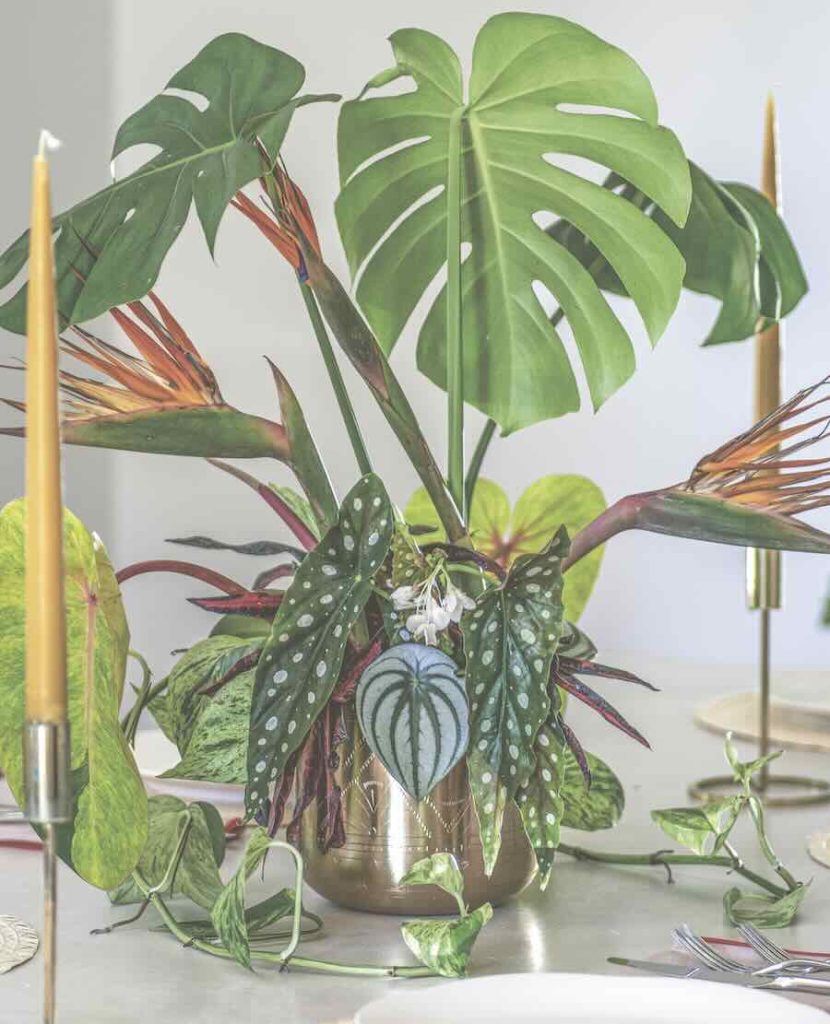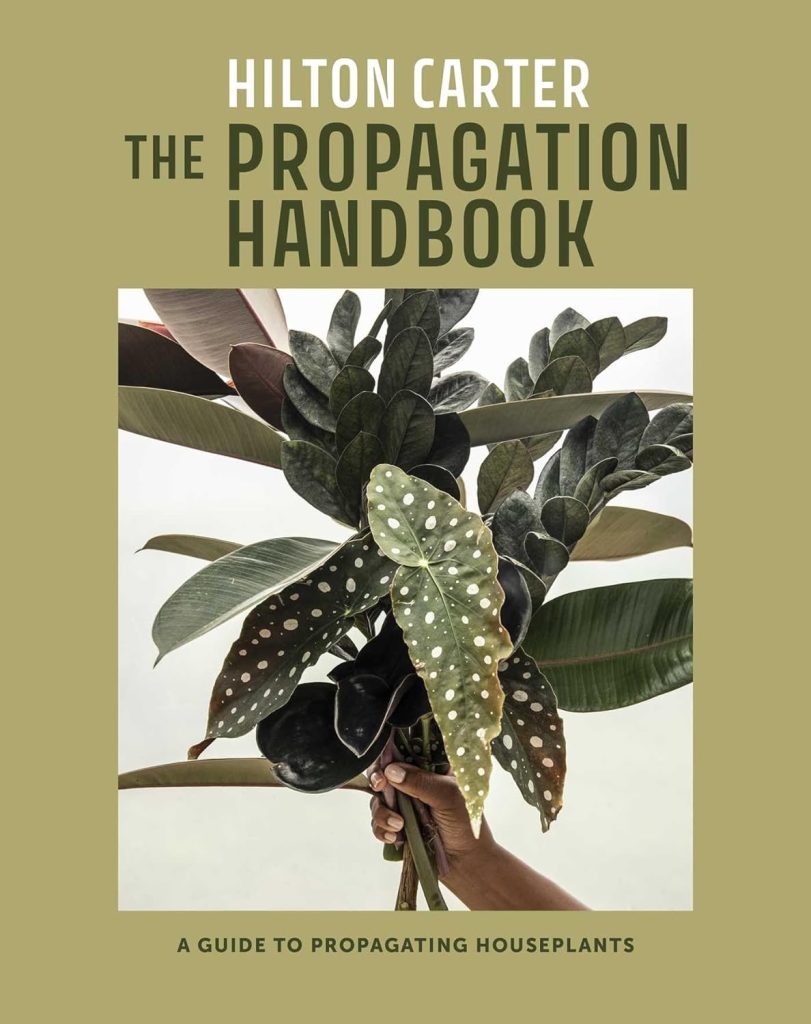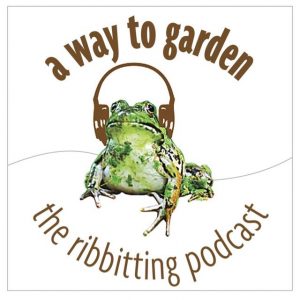I,FOR ONE, have a number of houseplants that would look a whole lot better right now if given a pinch or two or three, plus I could potentially enjoy the benefit of more plants from those trimmings, whether to keep, or better yet, to share. A new book by plant stylist Hilton Carter demystifies multiple methods of making more plants, including by various types of cuttings, and he filled me in, including on why rooting in water is his favorite medium of all.
“The Propagation Handbook” (affiliate link) just out, is Hilton’s fifth book, and you may know him from one of those, or his popular Instagram channel, or his merchandise at Target, his latest plant-decor collection there—including rotating pots so turning yours to give them even exposure to light is simpler than ever—is also just out.
Plus: Comment in the box near the bottom of the page for a chance to win a copy of his newest book.
Read along as you listen to the April 15, 2024 edition of my public-radio show and podcast using the player below. You can subscribe to all future editions on Apple Podcasts (iTunes) or Spotify (and browse my archive of podcasts here).
propagating houseplants, with hilton carter
Margaret Roach: My goodness, Hilton, you’ve been busy. New products, a new book, even a new special on PBS recently.
Hilton Carter: That is correct, yeah. You try to stay busy so you can stay young, I guess [laughter]. They say a body in motion stays in motion, so that’s what I’m trying to do and achieve myself.
Margaret: I see. O.K. Well, send me those tips for that as well, please [laughter]. So the new book which is not about body in motion, the new book, the “Propagation Handbook: A Guide to Propagating Houseplants:” I love toward the beginning where you write that plant propagation is “the gift that keeps on giving,” and indeed it is. And I think we’re in prime time right now with our houseplants. This is a good time to be thinking about this, yes?
Hilton: It definitely is. This is the time when we’re all trying to either figure out how to bring more plants into our home now that the season is changing, or we’re just trying to make our plants look their very best. We’re either repotting them, or hopefully, people are pruning back or propagating some of those plants.
Margaret: And it’s a good time to propagate, isn’t it, when they’re sort of coming back into active growth with lengthening days and other favorable factors? Is that true?
Hilton: Very true. Yeah. It’s very important to start that process, start the process of propagation during this time of the year, when your plants are active and pushing out new growth. Because not only are you taking a cutting from that mother plant to increase maybe your collection, or to gift to someone that you care for, but because that plant is in or the mother plant is in active growth, from where you make that cut, it’s not going to just stop the growth of that branch or that stem or that vine. From where you make that cut, somewhere on that particular part of the plant, new growth will start to develop.
Margaret: Right, because by this time of the year when my houseplants, they enjoyed their summer outside and in the early fall, came back inside, and they yelled at me the whole winter.
Hilton: [Laughter.] Of course.
Margaret: So I don’t have enough supplemental light. I should one of these days get it together and get some strip lights here in the house, but whatever. They could use a haircut, some of them, and I could make-
Hilton: They sure can.
Margaret: Yeah, I could make some extra plants. So in the book, you organize plants by the methods of propagation, various kinds of cuttings, some plants by division, some by spores or seed. And I’d love to focus in on the cuttings because as I just said, frankly, some of mine are looking a little weary right now and could use a cleanup, and there’s maybe this side benefit to capitalize on, that I’m going to get these extras.
So you subdivide cuttings into three sub-categories, so tell us what those three tactical kinds of cuttings are.
Hilton: So I’m guessing you’re talking about tip cut, stem cut and maybe leaf cut?
Margaret: Yeah.
Hilton: I think the process is basically… Because everyone gets a little excited about propagating. I know when I first propagated, I was just excited about the process. Someone told me I could take a cutting from a particular Pothos that I had, and I just cut it and I just lucked out in the process of being able to submerge a node in water. But when my second attempt at propagating a fiddle-leaf fig was that second plant, I just took the cut wherever I thought. I thought you could just cut it wherever, and I wasn’t successful.
So it’s about understanding where on the plants you can make these cuts. So while you can take a stem cut, let’s say, from a particular vine plant that has visible nodes that you can cut from and then submerge in water, a tip cut method is going to be for your more tree-like plants that you’re taking close to that tip of the plant and then submerging, whether that’s in water or wrapping in moss, whatever method you’re using.
And then leaf cuts, there are particular plants where you can actually just take a single leaf, place it in a propagation medium, like I said, water, moss, maybe even back in soil, and see that particular part of the plant develop and grow a new plant for you.
Margaret: So a couple of the viney growers, what would be a couple of examples and a couple that could be done in contrast by the leaves, for instance. I think some begonias can be done by just a leaf, right?
Hilton: For sure, for sure.
Margaret: So give us some examples that-
Hilton: So you might have, let’s say all of us love or most people who have a houseplant probably have some variation of a Pothos, or Pothos if that’s how you want to say it as well. Those particular plants are one of the easiest, I’ll say, plants to propagate. We’ve been known to see those propagate the most. Philodendron [above] are some of my favorite plants to propagate, and Monstera. Hoyas, I love a good Hoya, making the cut on the vine of a Hoya, placing it in water and watching it develop roots.
You can propagate certain I would say Peperomia [below] that way at the same time. But like you said, begonia is a particular plant that can be cut via tip cut but also just by taking a single leaf and propagating it that way as well. So if there’s particular plants that, let’s say in the stem cut family, I gave you those, that you’re looking for nodes to take a cut to propagate, but for your tip cut method, your Dracaena, your Ficus. There are so many wonderful Ficus you can take cuttings from. I just mentioned begonias as well. You can take a tip cut from your cacti and your succulent family, so there’s understanding the types of plants that require a particular method for best results.
Margaret: And so I assume, and you were talking about making the observations of where the growth points are and the structure of the plant and so forth. I imagine there was a little bit of trial and error along the way [laughter]. That’s how gardening is, that’s how planting is.
Hilton: Yeah, of course.
Margaret: So I imagine that you tried some things and it didn’t work. Like you said, with that second fiddle leaf fig, you tried it-
Hilton: For sure. Margaret, I will say this: For me, just to share a bit about my journey in this whole process of loving being a part of this green community and just working in plants is that there is so much trial and error. But I feel like the process of going through the motions, of taking a cutting and figuring it out, placing it, whether you are going to place it in water or you’re someone who wants to place it directly in the soil: Figuring those things out that’s going to work best for your plant, watching that process develop and grow roots and then figuring out the type of soil medium you’re going to make for that particular plant and then potting it in the pot that you think is going to work best for that plant. All those things to me, sometimes you have success, sometimes you have failure, but they make you better for the process of caring for that plant, but not only that plant, all the plants that you have.
I say in the book but I’ve said this in many places, it was propagation that changed how I understood how to care for all of my plants. And it’s very out there to say this as well, but it’s also what changed me, because it was… I’m going to say me personally, it changed who I was as a person, because it showed me that if you pay attention to the small details, the small nuances, and you decide to focus on what matters in every single step and you think about those things and you listen to what the plant is telling you, you can apply those things to the other living things, I say the other living things in your life. And so it was one of those things where if I had a failure, when I failed with that fiddle-leaf fig, I was distraught because I loved the plants that I took the cutting from, and I was just like, “What did I just do?” I just basically chopped off this limb of this plant and now, the plant, the mother plant is freaking out and the cutting’s not surviving.
And it was that moment, Margaret, it was that moment when I said to myself, “I’ve got to figure this out because I don’t want this to continue. I’ve got to figure out how to do this better,” and then that’s what starts the whole process.
So that’s when I say when I talk about the gift that keeps on giving. It’s not just the fact that you are taking the cutting from your plant and you are gifting it to a friend, but you’re also… The person that showed me how to propagate, they thought that they were just sharing a small bit of their love, their life, their world let’s say for propagating. They shared that with me and I ran with it, and now that became my entire world.
Margaret: So it’s not just plant growth, it’s personal growth, yeah?
Hilton: It surely is. It totally is that, because the thing is once you take that cutting and you share it with someone, they do have to work through all those steps and they’re pushed. When you buy a plant, let’s say, just from a store or you gift a plant to someone, the soil, the roots are already developed. The plant is somewhat developed, and now you’re just thinking about how much moisture to give it, how much light to give it.
But when you have or take a cutting or are gifted a cutting, you are then working through all the motions to grow and see the process to allow that plant to mature and thrive. And then there’s more of a bond, I will say, that is created because of that, and that’s when it becomes special. That’s when it becomes something that you want to share yourself, and that’s why it’s the gift that keeps on giving because you’re like, “Look what I did. I want to share this with others so they can feel what I’m feeling now.”
And that’s why I was like, I need to write this book because it is the thing that completely changed my heart, but also just made me just so excited to want to be or create the thing that I’ve created, whether it’s on social or write all these books. Because it is a wonderful thing to be a part of a community, I’ll say, where everyone’s just trying to figure out how to create these beautiful things, these beautiful living things in their home or outside of their home, and just feel so comfortable and relaxed and joyful around them.
What better gift to share with someone, or to share with the people who live in your home?
Margaret: Indeed, indeed. Well, one piece of guidance you give that caught my eye. You said, “Cut what you want to create.” So tell us what plants that applies to and why. Cut what you want to create: You were talking I believe about variegated plants and fenestrated plants with holes in them, Swiss-cheesy looking things. Cut what you want to create. What is-
Hilton: Cut what you want to create. I love it. Look, it’s the thing where you have to understand that… Like sometimes, I would get a friend that would say, “I got this cutting from an online seller. I got this cutting from an online seller and they showed a photo of this beautiful, variegated ‘Thai Constellation’ Monstera [above]. It had all these splits and holes, and then when mine started to develop and grow, it only had one split.”
And I was like, “Well, what did the initial cutting, that one leaf have on it?” They were like, “Well, it also had just one split.” And I was like, well, what they cut is going to push out that same type of growth that next leaf, but it can, if you take a cutting from a plant, let’s say it was a ‘Thai Constellation’ that had many splits and many holes, you are more likely to see that new growth mimic what was already there versus just give you a leaf that has less holes and less splits.
But over time, depending on how you care for it, whether you provide it really great light or you don’t provide it great light, or you don’t put it in the right spots in your home or give it the right moisture, things like that, that’s going to then start to alter how much, I would say, well, one the size of the leaf, but also the holes and the splits that you are then going to see. But it also relates to how much variegation you are going to get as well. That’s how so many of these, I like to call them “mutant plants,” [laughter] are being developed over time from growers, is that they’re taking the most, I would say, beautiful, variegated version of that plant and taking that cutting, and from that, reproducing more and more of that type of plant.
Margaret: Right. Selection, selection, selection, selection.
Hilton: Exactly. Exactly.
Margaret: Absolutely. Absolutely.
Hilton: So if you want that really, let’s say that white-leaved Hoya carnosa, take the vine that has the most white leaves and propagate that, and that’s what you more than likely will produce over time.
Margaret: Right. So as I mentioned in the introduction, though you cover how to root cuttings in moss I think and potting soil and so forth, you say that water’s your favorite medium. I’m paraphrasing there I believe.
Hilton: Yeah.
Margaret: So why is that? Why are you laughing?
Hilton: [Laughter.] I’m only laughing because there are so many ways to be successful at propagating, but I love water. I think most people love water. I’m going to be biased because it was the first way I learned how to propagate, but the reason why I love it so much is because when you’re propagating in moss or you’re going directly into soil, the beauty of the development of roots is not visible.You don’t get to see that development.
I love when… I’m sorry [laughter], I’m just getting a little overwhelmed.
Margaret: He really doesn’t like plants, people. He hates plants. This guy can’t stand plants. Do you hear that in his voice? O.K. [Laughter.]
Hilton: I’m so sorry. But yeah, when I first saw that node, that little node start to develop this aerial route let’s say, but a longer root, I was so jazzed about it because I thought, “What is this magic?” It’s so wonderful to see it grow and develop, and then have an understanding like, O.K., at this point, when should I then move it into a soil medium? O.K. It’s now developing and growing these roots. The roots are getting longer.
Being able to touch what is going to be the life source of the plant, and over time, grow into what’s happening above the surface of the pots later, that to me is such a wonderful thing to just see develop. So I’m one for growing and developing plants, propagating plants in whatever I would say medium you want to pick, but I’m just one who is just so in love with seeing roots develop in water and that’s the way I go.
Margaret: And there’s nothing in the water. You mentioned warm water to start, room temperature, lukewarm water, not icy cold or whatever to start with.
Hilton: For sure.
Margaret: But you are not using any rooting hormones. It’s water.
Hilton: I’m not. I just go directly in water, but I tell individuals that if they are going to try their best, let’s say, to continuously grow a plant in water, that they could use rooting hormone, they could use fertilizer in their water, but they’re going to have to change that water out very often.
Margaret: Yes. It gets nasty [laughter].
Hilton: Exactly. Exactly.
Margaret: Yeah. So speaking of rooting cuttings in water, oh my goodness, those living walls of yours. [Laughter.] And you have them in the book and they’re on your website, and people aren’t even going to know what I’m talking about. I don’t know if you can describe them. It’s almost like these clusters of test tubes that are in these beautiful wooden racks, and I believe it’s holders. And it’s just this whole grid on your wall, and I know that you make some of them and sell them and so forth, the holders and the test tubes. They’re not test tubes, you know what I mean. But at any rate, living walls [photo, top of page]: How in the world did that happen, and what did your wife say? [Laughter.]
Hilton: That’s the only question that’s important here. Honestly, I will say this, it was something that my wife said she was O.K. with when I came up with the idea to do so. Margaret, honestly, it’s one of those aha moments that came to me back in 2015. I was taking a trip in the department store and I saw a spice rack, and I wasn’t someone who cooks. I didn’t understand spices like that, but I was like, I know how to propagate and they’re selling a spice rack that can go on a wall. How about I take the spices, don’t put any spices in it but put water and a plant in it and grow them that way? And I was living in an apartment then. I really wanted a living wall, but when you live in an apartment, obviously you can’t do a lot of things that you want to do, because you don’t own the space.
So I told my wife, she was my girlfriend at the time, I was like, “Look, we have this beautiful wall that is north-facing but it’s facing this very large window. Instead of doing a living wall, we could do a propagation wall. I can have multiple…” I call them cradles because they hold little babies is what I would say [laughter]. We could put multiple of those up on the wall and we can have all of these cuttings on the wall.
Not just a way of styling the wall with greenery, but also for me, like I said, it’s all about being able to gift that process, a plant to someone. And I thought it was always just a wonderful idea that when people came over and they saw the wall, maybe they saw a plant that was in the wall that they didn’t have, that we could gift it to them so they could take it away and enjoy a piece of our home and bring it into their home.
Because that process of propagating, most people have gotten a cutting from their grandmother, maybe a best friend and that’s how they got started with propagating or growing plants. I just thought it was just a nice touch to be able to always gift someone something from our space, and it definitely was a plant from our wall. So if you were a friend of ours and you invited us over, let’s say for your housewarming or for your birthday party, you should know that you were getting a cutting from our wall and not just some random gift.
Margaret: And it’s just amazing because it’s not all the same cuttings by any means. It’s one of this, one of that, and it makes this gorgeous collage, arrangement, whatever. Mosaic: Mosaic maybe is the word to me. It’s like this living mosaic with these tests tube-like little glass water-filled things, as you say, in these wooden cradles. And oh my goodness, and it’s just this living, crazy wonderful thing.
Hilton: I love that you said living mosaic. That’s a beautiful way of saying that.
Margaret: Yeah. So on a related note then, you also in the book, and of course you’re well known for this, you have these, as you call them in the book, “DIY bouquets.” So tell us about those because the cuttings from houseplants aren’t just for propagating, are they?
Hilton: No. So many times when you bring flowers in, and I love a bouquet of flowers, I just wanted to find a way to give people an option. I love options. I’m a man that loves options, but I just think that if you have the ability to create these beautiful moments, just like a bouquet of flowers, these arrangements, maybe that’s for a coffee table or some sort of centerpiece, that whatever you’re taking cuttings from, that they could live on. So while they’re there for the moment to be beautiful, all these different stems, especially…
Hopefully by the time you get to that chapter in the book, you have already learned how to propagate properly, that you’re able to take these cuttings from different plants in your home thinking about the theme, let’s say, of the bouquet like most floral designers do. They think about what they’re trying to create for that moment, whether it’s a moodier, whether it’s a bright moment, whether it’s a very colorful poppy moment.
You’re taking these plants, thinking about all those different things, these cuttings, and you’re placing them in a vessel that also talks about or speaks on that particular theme, and then while they’re sitting there, just like a bouquet of flowers would, they are developing and growing roots. So now, you’re then able to take them and then pot them, and then now you have extra plants, and you continue that process throughout your home versus just now a week or two later, now your flowers are dead and now you have to toss them out. It’s just a way to think. Again, especially right now when we’re in earth month, a way to be more sustainable, a way to just think more, I guess, about how we are greening our planet and being a bit more self-aware about how we care for just not our home but the plants and things around us as well.
Margaret: Yeah. We only have a couple of minutes left so it made me think, I have a couple of very overgrown Syngonium. I had them outside last year. They’re like vines now, really, vines, and I thought, wow, they’re going to yield more cuttings than I need to propagate. I could probably make the base of some gorgeous arrangements with them and enjoy them that way, too. So one last tip I want to make sure we give people is, O.K., so we’ve got these things on your living wall and in these other water vessels and so forth that are rooting, but we don’t want to let them root to where they have 6 inches of roots before we then try to pot them up. Isn’t there a point at which ideally, they should be transitioned into…? That’s what I always wonder, do you know what I mean?
Hilton: Yeah. Well, I would definitely take them at a 3- to 6-inch growth. As long as the cutting is getting what it needs, the roots are having their water refreshed, whether you are adding fertilizer or whatever you’re doing to keep that process going, you can continue to grow those roots if you want. It’s just then that transition that you’re going to move into, whatever medium it is, just making sure that you’re placing them in the right vessel that is going to help that particular root system, that you now have that root ball that you now have, and help that continuously get the moisture that it needs for the plant to grow.
Margaret: Right, so to go from water to a potting medium, you’re going to have to keep up with the watering-
Hilton: Exactly.
Margaret: … in the potting medium. You can’t put it in a dry, dusty, soilless mix and expect it to do fine on its own instantly.
Hilton: Exactly, and that’s the thing that most people have a hard time with. They’re like, “I’m able to grow roots, but as soon as I transition it into soil, my plant dies.” And I think that’s the thing, and I always say a successful propagation isn’t just a development of roots. It is when you’ve been able to transition that cutting with roots into soil, and then see it then grow, and take a cutting from it. That’s when you know you have truly been successful at propagating a plant.
Margaret: That’s like multi-generational there, Hilton [laughter].
Hilton: Exactly.
Margaret: You have big expectations. Well, I’m so glad to speak to you and congratulations again on “The Propagation Handbook: A Guide to Propagating Plants.” I think people are really going to enjoy it. And boy, oh boy, so you’re running all over the place doing a million things, but it’s very exciting.
Hilton: Yeah. I have a book tour. I’m going out on tour, but it’s been an absolute pleasure, Margaret, to be on the show today.
(All photos by Hilton Carter from “The Propagation Handbook; used with permission.)
enter to win a copy of ‘the propagation handbook’
I’LL BUY A COPY of “The Propagation Handbook” by Hilton Carter for one lucky reader. All you have to do to enter is answer this question in the comments box below:
Is there a houseplant you have successfully propagated (or if not, tell us one attempt that failed!)?
No answer, or feeling shy? Just say something like “count me in” and I will, but a reply is even better. I’ll pick a random winner after entries close at midnight Tuesday, April 23, 2024. Good luck to all.
(Disclosure: As an Amazon Associate I earn from qualifying purchases.)
prefer the podcast version of the show?
MY WEEKLY public-radio show, rated a “top-5 garden podcast” by “The Guardian” newspaper in the UK, began its 15th year in March 2024. It’s produced at Robin Hood Radio, the smallest NPR station in the nation. Listen locally in the Hudson Valley (NY)-Berkshires (MA)-Litchfield Hills (CT) Mondays at 8:30 AM Eastern, rerun at 8:30 Saturdays. Or play the April 15, 2024 show using the player near the top of this transcript. You can subscribe to all future editions on iTunes/Apple Podcasts or Spotify (and browse my archive of podcasts here).


